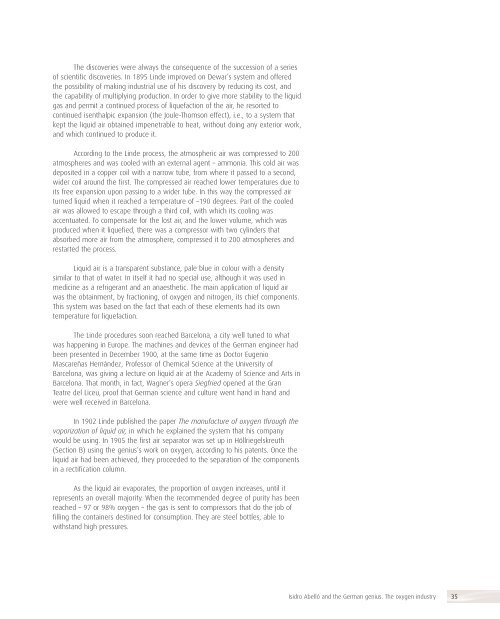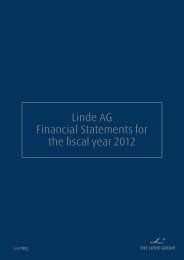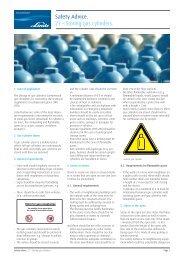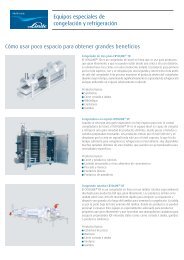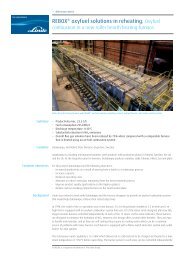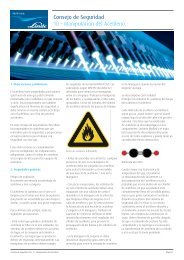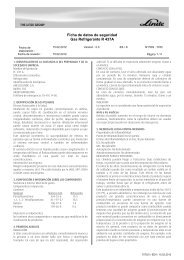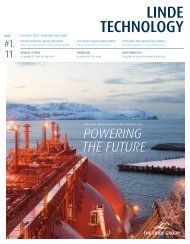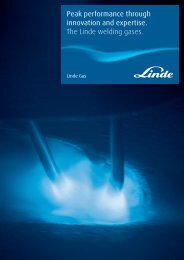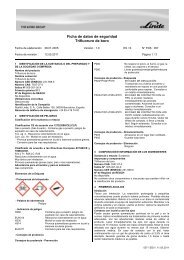Abelló Linde Centenary Book
Abelló Linde Centenary Book
Abelló Linde Centenary Book
You also want an ePaper? Increase the reach of your titles
YUMPU automatically turns print PDFs into web optimized ePapers that Google loves.
The discoveries were always the consequence of the succession of a series<br />
of scientific discoveries. In 1895 <strong>Linde</strong> improved on Dewar’s system and offered<br />
the possibility of making industrial use of his discovery by reducing its cost, and<br />
the capability of multiplying production. In order to give more stability to the liquid<br />
gas and permit a continued process of liquefaction of the air, he resorted to<br />
continued isenthalpic expansion (the Joule-Thomson effect), i.e., to a system that<br />
kept the liquid air obtained impenetrable to heat, without doing any exterior work,<br />
and which continued to produce it.<br />
According to the <strong>Linde</strong> process, the atmospheric air was compressed to 200<br />
atmospheres and was cooled with an external agent – ammonia. This cold air was<br />
deposited in a copper coil with a narrow tube, from where it passed to a second,<br />
wider coil around the first. The compressed air reached lower temperatures due to<br />
its free expansion upon passing to a wider tube. In this way the compressed air<br />
turned liquid when it reached a temperature of –190 degrees. Part of the cooled<br />
air was allowed to escape through a third coil, with which its cooling was<br />
accentuated. To compensate for the lost air, and the lower volume, which was<br />
produced when it liquefied, there was a compressor with two cylinders that<br />
absorbed more air from the atmosphere, compressed it to 200 atmospheres and<br />
restarted the process.<br />
Liquid air is a transparent substance, pale blue in colour with a density<br />
similar to that of water. In itself it had no special use, although it was used in<br />
medicine as a refrigerant and an anaesthetic. The main application of liquid air<br />
was the obtainment, by fractioning, of oxygen and nitrogen, its chief components.<br />
This system was based on the fact that each of these elements had its own<br />
temperature for liquefaction.<br />
The <strong>Linde</strong> procedures soon reached Barcelona, a city well tuned to what<br />
was happening in Europe. The machines and devices of the German engineer had<br />
been presented in December 1900, at the same time as Doctor Eugenio<br />
Mascareñas Hernández, Professor of Chemical Science at the University of<br />
Barcelona, was giving a lecture on liquid air at the Academy of Science and Arts in<br />
Barcelona. That month, in fact, Wagner’s opera Siegfried opened at the Gran<br />
Teatre del Liceu, proof that German science and culture went hand in hand and<br />
were well received in Barcelona.<br />
In 1902 <strong>Linde</strong> published the paper The manufacture of oxygen through the<br />
vaporization of liquid air, in which he explained the system that his company<br />
would be using. In 1905 the first air separator was set up in Höllriegelskreuth<br />
(Section B) using the genius’s work on oxygen, according to his patents. Once the<br />
liquid air had been achieved, they proceeded to the separation of the components<br />
in a rectification column.<br />
As the liquid air evaporates, the proportion of oxygen increases, until it<br />
represents an overall majority. When the recommended degree of purity has been<br />
reached – 97 or 98% oxygen – the gas is sent to compressors that do the job of<br />
filling the containers destined for consumption. They are steel bottles, able to<br />
withstand high pressures.<br />
Isidro Abelló and the German genius. The oxygen industry 35


